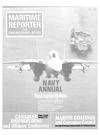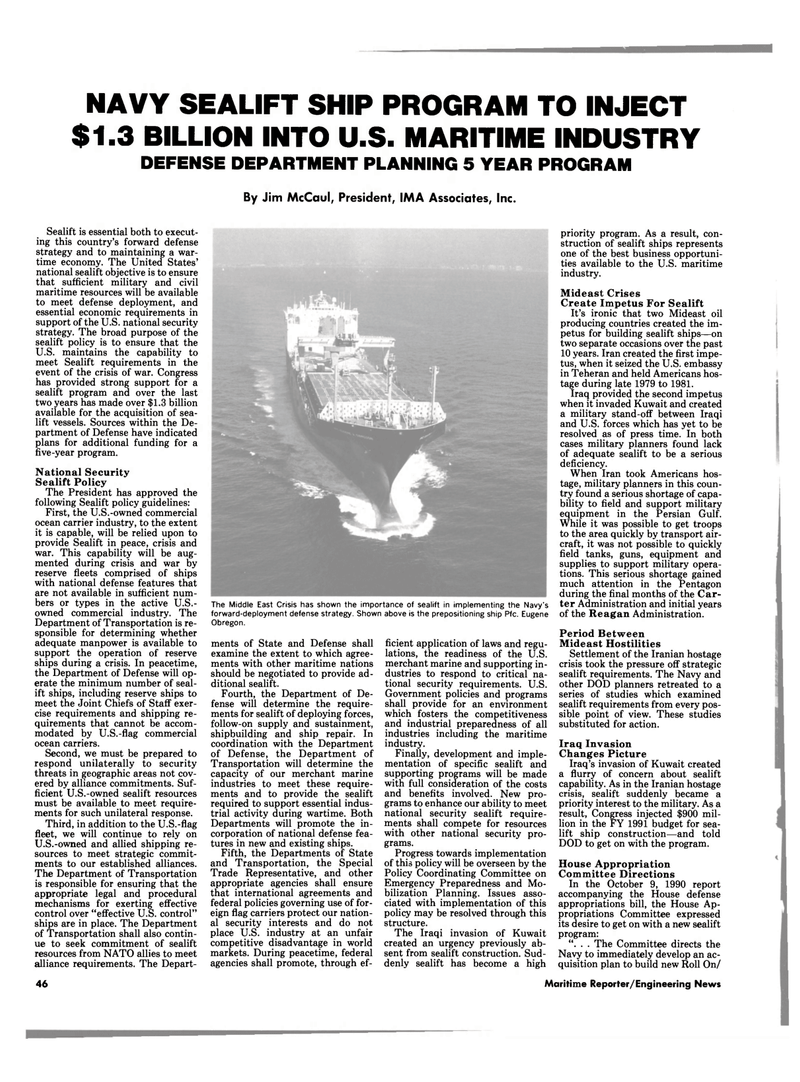
Page 44: of Maritime Reporter Magazine (February 1991)
Read this page in Pdf, Flash or Html5 edition of February 1991 Maritime Reporter Magazine
NAVY SEALIFT SHIP PROGRAM TO INJECT $1.3 BILLION INTO U.S. MARITIME INDUSTRY
DEFENSE DEPARTMENT PLANNING 5 YEAR PROGRAM
By Jim McCaul, President, IMA Associates, Inc.
The Middle East Crisis has shown the importance of sealift in implementing the Navy's forward-deployment defense strategy. Shown above is the prepositioning ship Pfc. Eugene
Obregon.
Sealift is essential both to execut- ing this country's forward defense strategy and to maintaining a war- time economy. The United States' national sealift objective is to ensure that sufficient military and civil maritime resources will be available to meet defense deployment, and essential economic requirements in support of the U.S. national security strategy. The broad purpose of the sealift policy is to ensure that the
U.S. maintains the capability to meet Sealift requirements in the event of the crisis of war. Congress has provided strong support for a sealift program and over the last two years has made over $1.3 billion available for the acquisition of sea- lift vessels. Sources within the De- partment of Defense have indicated plans for additional funding for a five-year program.
National Security
Sealift Policy
The President has approved the following Sealift policy guidelines:
First, the U.S.-owned commercial ocean carrier industry, to the extent it is capable, will be relied upon to provide Sealift in peace, crisis and war. This capability will be aug- mented during crisis and war by reserve fleets comprised of ships with national defense features that are not available in sufficient num- bers or types in the active U.S.- owned commercial industry. The
Department of Transportation is re- sponsible for determining whether adequate manpower is available to support the operation of reserve ships during a crisis. In peacetime, the Department of Defense will op- erate the minimum number of seal- ift ships, including reserve ships to meet the Joint Chiefs of Staff exer- cise requirements and shipping re- quirements that cannot be accom- modated by U.S.-flag commercial ocean carriers.
Second, we must be prepared to respond unilaterally to security threats in geographic areas not cov- ered by alliance commitments. Suf- ficient U.S.-owned sealift resources must be available to meet require- ments for such unilateral response.
Third, in addition to the U.S.-flag fleet, we will continue to rely on
U.S.-owned and allied shipping re- sources to meet strategic commit- ments to our established alliances.
The Department of Transportation is responsible for ensuring that the appropriate legal and procedural mechanisms for exerting effective control over "effective U.S. control" ships are in place. The Department of Transportation shall also contin- ue to seek commitment of sealift resources from NATO allies to meet alliance requirements. The Depart- ments of State and Defense shall examine the extent to which agree- ments with other maritime nations should be negotiated to provide ad- ditional sealift.
Fourth, the Department of De- fense will determine the require- ments for sealift of deploying forces, follow-on supply and sustainment, shipbuilding and ship repair. In coordination with the Department of Defense, the Department of
Transportation will determine the capacity of our merchant marine industries to meet these require- ments and to provide the sealift required to support essential indus- trial activity during wartime. Both
Departments will promote the in- corporation of national defense fea- tures in new and existing ships.
Fifth, the Departments of State and Transportation, the Special
Trade Representative, and other appropriate agencies shall ensure that international agreements and federal policies governing use of for- eign flag carriers protect our nation- al security interests and do not place U.S. industry at an unfair competitive disadvantage in world markets. During peacetime, federal agencies shall promote, through ef- ficient application of laws and regu- lations, the readiness of the U.S. merchant marine and supporting in- dustries to respond to critical na- tional security requirements. U.S.
Government policies and programs shall provide for an environment which fosters the competitiveness and industrial preparedness of all industries including the maritime industry.
Finally, development and imple- mentation of specific sealift and supporting programs will be made with full consideration of the costs and benefits involved. New pro- grams to enhance our ability to meet national security sealift require- ments shall compete for resources with other national security pro- grams.
Progress towards implementation of this policy will be overseen by the
Policy Coordinating Committee on
Emergency Preparedness and Mo- bilization Planning. Issues asso- ciated with implementation of this policy may be resolved through this structure.
The Iraqi invasion of Kuwait created an urgency previously ab- sent from sealift construction. Sud- denly sealift has become a high priority program. As a result, con- struction of sealift ships represents one of the best business opportuni- ties available to the U.S. maritime industry.
Mideast Crises
Create Impetus For Sealift
It's ironic that two Mideast oil producing countries created the im- petus for building sealift ships—on two separate occasions over the past 10 years. Iran created the first impe- tus, when it seized the U.S. embassy in Teheran and held Americans hos- tage during late 1979 to 1981.
Iraq provided the second impetus when it invaded Kuwait and created a military stand-off between Iraqi and U.S. forces which has yet to be resolved as of press time. In both cases military planners found lack of adequate sealift to be a serious deficiency.
When Iran took Americans hos- tage, military planners in this coun- try found a serious shortage of capa- bility to field and support military equipment in the Persian Gulf.
While it was possible to get troops to the area quickly by transport air- craft, it was not possible to quickly field tanks, guns, equipment and supplies to support military opera- tions. This serious shortage gained much attention in the Pentagon during the final months of the Car- ter Administration and initial years of the Reagan Administration.
Period Between
Mideast Hostilities
Settlement of the Iranian hostage crisis took the pressure off strategic sealift requirements. The Navy and other DOD planners retreated to a series of studies which examined sealift requirements from every pos- sible point of view. These studies substituted for action.
Iraq Invasion
Changes Picture
Iraq's invasion of Kuwait created a flurry of concern about sealift capability. As in the Iranian hostage crisis, sealift suddenly became a priority interest to the military. As a result, Congress injected $900 mil- lion in the FY 1991 budget for sea- lift ship construction—and told
DOD to get on with the program.
House Appropriation
Committee Directions
In the October 9, 1990 report accompanying the House defense appropriations bill, the House Ap- propriations Committee expressed its desire to get on with a new sealift program: ". . . The Committee directs the
Navy to immediately develop an ac- quisition plan to build new Roll On/ 46 Maritime Reporter/Engineering News

 43
43

 45
45
